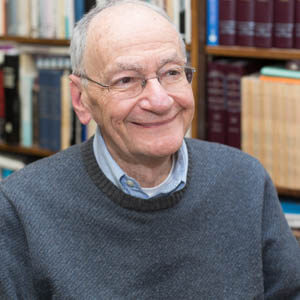
On Writing Torah Commentaries
Jul 9, 2005 By Ismar Schorsch | Commentary | Hukkat
As I begin my twentieth and final year as Chancellor, I am mindful of the cautionary verse from Proverbs, wisely inserted by our sages in the morning liturgy: “Many are the designs of the human heart, but in the end, it is God’s plan that will prevail.”
Read More
Miriam’s Death
Jun 16, 1999 By Ismar Schorsch | Commentary | Balak | Hukkat
Biblical narrative begs for reader participation. Time and again we come across a story short on context, background and human emotions, traces of an event barely recalled and crying out for elucidation. This week’s parasha contains a gem of an example.
Read More
The Centrality of Torah Study
Jun 30, 2001 By Ismar Schorsch | Commentary | Hukkat
For the Rabbis, the words of Torah are infinitely plastic because they are infinitely meaningful. If God be infinite, so is God’s language. Via creative interpretation, midrash, the Rabbis dismantle and reassemble individual words, phrases and verses to pour new meanings into old vessels, turning a static text into one that is ever in formation.
Read More
Infusing the World with Holiness
Jul 12, 2003 By Ismar Schorsch | Commentary | Balak | Hukkat
After two impressive victories against the Canaanites of the Negeb and the Amorites in Transjordan, the looming military might of Israel throws the leaders of Moab into a panic. Only the land of the Moabites separates Israel from the Jordan River and the conquest of Canaan. Balak ben Zippor, King of Moab, knows that he is next. In desperation, he takes recourse in an unconventional pre-emptive measure. He summons Balaam son of Beor, a sorcerer from Mesopotamia to curse Israel, making it susceptible to defeat on the battlefield. Though Balaam comes, God frustrates the plan. Within the monotheistic framework of the Torah, Balaam can utter only what God imparts to him. Hence he ends up in rapturous praise of Israel, to the consternation of Balak.
Read More
In Memory of Zvia Ben-Yosseph Ginor
Jun 26, 2004 By Ismar Schorsch | Commentary | Hukkat
Great art is often a triumph over great suffering. In 1999, The Jewish Theological Seminary faculty suffered the grievous loss of one of its own, Zvia Ben-Yosseph Ginor, to cancer at the height of her literary power. With her keen intellect and exuberant personality, she cut a figure larger than life. Zvia had come to JTS in mid-life with impressive credentials, to pursue a doctorate in Jewish literature. She was the daughter of the founder of Israel’s airplane industry, a published Hebrew poet and a sterling adult educator. For her dissertation, she wrote on the Hebrew poetry of Abba Kovner, the legendary Vilna partisan and creator of the Diaspora Museum in Tel Aviv. Shortly after completion, the work was published in Israel.
Read More
Hearing God’s Voice
Jul 8, 2006 By Matthew Berkowitz | Commentary | Hukkat
We communicate with each other and with God through our voices.
Read More
The Sin of Moses
Jul 4, 2009 By Deborah Miller | Commentary | Balak | Hukkat
Everyone knows how Romeo and Juliet ends, and yet we still cry when they die. The same is true of the first of the two Torah portions we read this week, Parashat Hukkat/Balak. In this portion, we learn that Moses will not enter the Promised Land. We have heard or read this story every year, and yet we are still upset, still angry that, on the threshold, Moses is denied admission to the Land to which he has been leading the Israelites for forty years.
Read More
The Mystery of the Red Heifer
Jun 19, 2010 By Barry Holtz | Commentary | Hukkat
This week’s Torah reading opens with one of the most mysterious and incomprehensible rituals in the entire Bible. Numbers 19:1–22 describes the ritual of the red heifer—the complex practice that allows a person who has come in contact with a dead body to become “purified” of the contamination (tu’mah) that accompanies connection to those who have died. A red heifer is slaughtered, its body and blood are burned in a fire with certain woods and plants, and the ashes that remain after that burning are used in a mixture with water to create a kind of paste that is sprinkled on those who have come in contact with a corpse.
Read More


